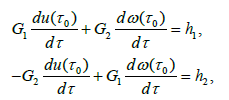Research Article, Res Rep Math Vol: 2 Issue: 4
Sufficient condition of the Hopf bifurcation
Amine Bernoussi*
Department of Mathematics, Faculty of Science, Ibn Tofail University, Kenitra, Morocco
*Corresponding Author : Amine Bernoussi
Department of Mathematics, Faculty of Science, Ibn Tofail University, BP 133, 14000, Kenitra, Morocco
E-mail: amine.bernoussi@yahoo.fr
Received: September 15, 2018 Accepted: December 04, 2018 Published: December 11, 2018
Citation: Bernoussi A (2018) Sufficient Condition of the Hopf Bifurcation. Res Rep Math 2:4
Abstract
In this paper we propose a new sufficient condition for the Hopf bifurcation of equilibrium is derived for nonlinear autonomous differential equations with delay in three dimension, by analysis the characteristic equation.
Keywords: Hopf bifurcation; Local stability bifurcation the hopf; Differential equations
Introduction
In this paper, we propose the following sufficient condition for the local Hopf bifurcation for a differential equation system with delay the form:

The initial condition for the above system is

with φ=(φ1, φ2, φ3) where φi∈C(i=1,2,3), such that φi(θ) ≥ 0(-τ≤θ≤ 0,i=1,2,3). Here C denotes the Banach space C([-τ,0]R) of continuous functions mapping the interval [-τ,0] into R, equipped with the supremum norm. The non-negative cone of C is defined as C+= C([-τ,0], R+), where R+={x∈ R|x ≥ 0}. We here assume that f: R3→ R is a locally Lipschitz continuous function on R3 Suppose that the equation (1) has a equilibrium point P*; and the characteristic equation of the equation (1) around the equilibrium point P* takes the general form:

With

and

The main results are as follows
Theorem 1 (Amine Bernoussi) Assume that the equilibrium P* of system (1) is locally asymptotically stable for τ=0:
If  Then there exists a positive τ0 such that, when τ∈[0,τ0) the steady state P* is locally asymptotically stable, and a Hopf bifurcation occurs as τ passes through τ0; where τ0 is given by
Then there exists a positive τ0 such that, when τ∈[0,τ0) the steady state P* is locally asymptotically stable, and a Hopf bifurcation occurs as τ passes through τ0; where τ0 is given by

and ω0 is the least simple positive root of equation (5), and c, b and Þz are defined in lemma 2 and equation (5). further we have

The organization of this paper is as follows. In section 2, we offer basic results for the prove of theorem 1. In section 3, we establish the local asymptotic stability and the Hopf bifurcation of the equilibrium P* and prove theorem 1. Finally a discussion and conclusion is offered in section 4.
Basic Results
We offer some basic results for the prove of theorem 1. Now we return to the study of equation (2) with τ>0. Equation (2) has a purely imaginary root iω, with ω>0:
Δ(iω, τ)=0
if and only if

Squaring and adding the squares together, we obtain

with  where A, B, C, D, E and F are given by (2).
where A, B, C, D, E and F are given by (2).
Letting z=ω2, equation (5) becomes the following cubic equation

Lemma 2 [5] Define

(i) If c < 0, then equation (6) has at least one positive root.
(ii) If c ≥ 0 and Δ ≤ 0, then equation (6) has no positive roots.
(iii) If c ≥ 0 and Δ>0, then equation (6) has positive roots if and
only if 
From lemma 2, we have the following lemma.
Lemma 3 Assume that the equilibrium P* of system (1) is locally asymptotically stable for τ=0
(i) If one of the following:
(N1) c ≥ 0, and Δ ≤ 0,
(N2) c ≥ 0, Δ>0, and Þz ≤ 0,
(N3) c ≥ 0, Δ>0, and h( Þz )>0,
is true, then all roots of equation (2) have negative real parts for all τ ≥ 0.
(ii) If c<0, or c ≥ 0, Δ>0, Þz >0, and h( Þz )≤ 0, then all roots of equation (2) have negative real parts when

where Δ and Þz >0 are defined in lemma 2
Sufficient Condition of the Hopf Bifurcation
In this section, we establish the condition sufisent of the Hopf bifurcation of the equilibrium P*.
Theorem 4 Assume that the equilibrium P* of system (1) is locally asymptotically stable for τ=0.
If  Then there exists a positive τ0 such that, when τ∈[0, τ0) the steady state P* is locally asymptotically stable, and a Hopf bifurcation occurs as τ passes through τ0, where τ0 is given by
Then there exists a positive τ0 such that, when τ∈[0, τ0) the steady state P* is locally asymptotically stable, and a Hopf bifurcation occurs as τ passes through τ0, where τ0 is given by

and ω0 is the least simple positive root of equation (5), and c, b and z are defined in lemma 2 and equation (5). further we have

Proof. Consider the equation

the discriminant Δ1 of the equation (8) is given by

or by the hypothes c ≥ 0 and  therefore equation (8) admits two solutions
therefore equation (8) admits two solutions

then we have

the hypotheses  implies that
implies that Therefore
Therefore

On the other since from the hypotheses b<0 then Δ>0 then the hypotheses (iii) of the Lemma 2 is satisfied. Hence the equation (6) has at least one positive solution, more Lemma 3 implies that all roots of equation (2) have negative real parts when τ [0, τ0).
Now we will determine τ0.
Without loss of generality, we assume that the equation (6) has three positive roots, denoted by z1, z2 and z3, respectively.
Then equation (5) has three positive roots, say

According to equations (3) and (4) we have

Then ±iωl is a pair of purely imaginary roots of equation (2) with  clearly,
clearly,

Thus, we can define

Next we need to guarantee the transversality condition of the Hopf bifurcation theorem [1-4].

And

Let u(τ) and ω(τ) satisfying u(τ0)=0, and ω(τ0)=ω0. By differentiating the equations (9) and (10) with respect to τ and then set τ=τ0. Doing this, we get

Where

Solving for  we get
we get

Therefore we have

Note that if  h(0)=c≥0.
h(0)=c≥0.
Thus if  we have the transversality condition:
we have the transversality condition:

If  and close to τ0, then equation (2) has a root λ(τ) = u(τ)+iω(τ) satisfying u(τ)>0, which contradicts (ii) of Lemma 3. This completes the proof.
and close to τ0, then equation (2) has a root λ(τ) = u(τ)+iω(τ) satisfying u(τ)>0, which contradicts (ii) of Lemma 3. This completes the proof.
Remark 5 Our main result also valid for any differential equation of higher dimension three provided that the study of the characteristic equation of the equation reduces to study the equation (2) and more generally all the problems in Rn has equation of the form [5-7]:

Conclusion
In this work, we presented a mathematical analysis for a nonlinear autonomous differential equation with delays in three dimensions. The originality of this work is to have a new sufficient condition for the Hopf bifurcation of equilibria. On the other hand, the main results can be generalized to differential equation of dimension greater than three (see Remark 5).
References
- J.K. Hale and S.M. Verduyn Lunel, Introduction to Functional Differential Equations, Springer- Verlag, New York, 1993.
- B. D. Hassard, N. D. Kazarinoff, and Y. H. Wan, Theory and Applications of Hopf Bifurcation. Cambridge: Cam- bridge University Press.
- Y. Kuang; Delay Differentiel Equations With Applications in Population Dynamics, Aca-demic Press, INC., New York 1993.
- Shigui Ruan, Junjie Wei, On the zeroes of transcendental functions with applications to the stability of delay differ- ential equations, Journal Dynamics of continuous, discrete and impulsive systems, SER. A: Mathematical Analysis. volume, 10. PP. 863–874. 2003.
- S. Ruan, J. Wei, On the zeros of a third degree exponential polynomial with applications to a delayed model for the control of testosterone secretion. IMA J. Math. App. Med. Biol. 18, 41?52,2001.
- R. Xu ; Global dynamic of a delayed epidemic model with latency and relapse, Nonlinear Analysis : Modelling and control, 2013 ,vol.18,No.2,250-263 436-444.
- R. Xu ; Global dynamics of an SEIRI epidemiological model with time delay, Applied Math- ematics and Computa- tion Volume 232, 1 April 2014, Pages 436-444.
 Spanish
Spanish  Chinese
Chinese  Russian
Russian  German
German  French
French  Japanese
Japanese  Portuguese
Portuguese  Hindi
Hindi 